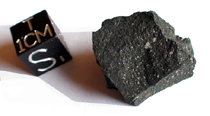CM Group
This group is named for its type specimen, the meteorite of Mighei,
which fell in Ukraine in 1889, and it has many more members than the
previous group. About 80 chondrites of the CM group are known, and they
mostly belong to petrologic type 2, although certain lithologies in some
of its members are known to belong to type 1 (e.g. in Cold Bokkeveld).
With about 10% water, they contain less than the CI chondrites and show
less aqueous alteration so that some chondrules have been well preserved.
Those chondrules consist of olivine and are scattered throughout the black
matrix. In that mixture of phyllosilicate and magnetite, similar to the
matrix of the CI chondrites, one also finds light-coloured inclusions.
These high-temperature silicates are lacking in the CI group.
As with the CI chondrites, the CM chondrites are well known to contain
a wealth of complex organic compounds. The well-studied meteorite of
Murchison, a CM2 that fell in Australia in 1969, was found to contain more
than 230 different amino acids, whereas on earth only 20 different amino
acids are known and used as fundamental building blocks of life. Some of
these extraterrestrial amino acids were found to exhibit strange isotopic
signatures that might indicate that they don't have their origin within
our solar system. These amino acids are believed to represent actual
interstellar matter from other systems and nebulae that were trapped in
this meteorite more than 4.5 billion years ago.
|
Cold Bokkeveld
Oct. 13, 1838, South Africa
6 kg
CM2
Historic fall!!!
|
 
|
|
|
|
Cold Bokkeveld 00
4.784 gr
Very nice fragment with an open window for this historical fall !
SOLD
|
|
|
|
|
|
|
|